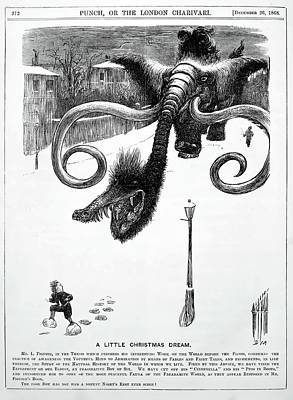An example of the sentimental family scene is this Punch cartoon by John Leech (1817-1864), "A Family Group, Baby Stirring the Pudding." The large-headed Mr. Punch is at the center, helping "Baby," surrounded by admiring adults and children.
The 1840s saw several important developments in the creation of today's Christmas traditions. That decade saw the introduction of the first Christmas cards, by Henry Cole, a British civil servant. This one below, said to be the very first, shows a prosperous and respectable family enjoying a holiday meal.
The publication of A Christmas Carol by Charles Dickens in 1843 helped reinforce the sentimental trend. John Leech's illustration of Mr. Fezziwig's Christmas party conveys a nostalgic view of the time when Ebenezer Scrooge was his young employee. The jolly, humane Fezziwig dances under the mistletoe in a room full of happy revelers. Dickens implies that this is how Christmas could be, or rather, should be.
Fezziwig's party stands in sharp contrast to the Christmas day meal of the Cratchit family. The occasion is pious, sentimental, loving, but meager -- meager at least until the reformed Scrooge shows up with presents, a big turkey, trimmings, and a raise for Bob Cratchit. Now enlightened, Scrooge makes Christmas what it should be.
The decorated Christmas tree began to take front and center in portrayals of the holiday during the Victorian Age. The Hanoverian monarchs had introduced the Christmas tree from Germany in the 18th century.
But few of the British adopted the custom begore the reign of Queen Victoria. Beginning in the 1840s, her German husband Prince Albert helped to popularize the Christmas Tree. The image below shows the royal family admiring Das Tannenbaum.
The cartoon below, from a radical newspaper, pictures the royals and company gorging themselves on a giant Christmas pudding, or "Blom Buddin" as Prince Albert calls it. Albert is presented as a freeloader helping himself the "good tings of Angland."
Victoria hands a plate of plum stones to John Bull, the "cook" of the pudding, and says he can lick the dish and suck the stones when the family have finished. Bull represents the people who have created the country's wealth but live on crumbs.
Victorian Christmas images, such as the one below by John Tenniel from Punch in 1883, occasionally focused on those for whom the holiday was just another day of deprivation and poverty. Here, Father Christmas confronts a poorly dressed child who lives in a cellar and knows nothing about him. "This must be altered," he says, presumably meaning such dire poverty as well as ignorance of the Great Present Giver.
Some Christmas Cartoons could be positively frightening, in a humorous way, at least. An example is George Du Maurier's Christmas cartoon in Punch, 1865. The caption refers to a naturalist who says that children should not read fables and fairy tales but read natural history instead. "Here is the result [of reading natural history] on the youthful mind" Du Maurier comments tongue-in-cheek.










